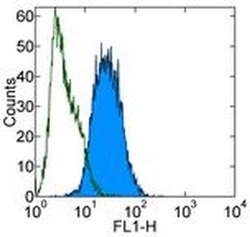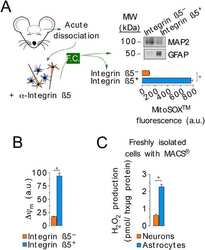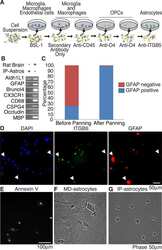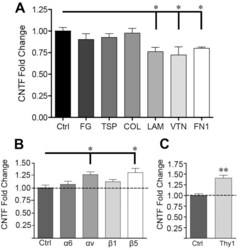Antibody data
- Antibody Data
- Antigen structure
- References [5]
- Comments [0]
- Validations
- Flow cytometry [1]
- Other assay [3]
Submit
Validation data
Reference
Comment
Report error
- Product number
- 11-0497-41 - Provider product page

- Provider
- Invitrogen Antibodies
- Product name
- Integrin beta 5 Monoclonal Antibody (KN52), FITC, eBioscience™
- Antibody type
- Monoclonal
- Antigen
- Other
- Description
- Description: The KN52 antibody reacts with human integrin beta 5, an approximately 100,000 Mr (reduced) and 95,000 Mr (nonreduced) a member of the integrin family. Only a single alpha chain, the alpha v subunit, associates with the integrin beta 5 to form the vitronectin receptor complex. Integrin alpha v/beta 5 complex also binds to the basic domain of Tat (he sequence RKKRRQRRR). The integrin beta 5 is found on carcinoma cell lines, hepatoma and fibroblast cell lines, and is absent from lymphoblastoid cells and platelets. The KN52 monoclonal antibody has been shown to inhibit migration. Applications Reported: This KN52 antibody has been reported for use in flow cytometric analysis. Applications Tested: This KN52 antibody has been pre-titrated and tested by flow cytometric analysis of Chinese Hamster Ovary (CHO), A549 and normal human peripheral blood cells. This can be used at 5 µL (0.125 µg) per test. A test is defined as the amount (µg) of antibody that will stain a cell sample in a final volume of 100 µL. Cell number should be determined empirically but can range from 10^5 to 10^8 cells/test. Excitation: 488 nm; Emission: 520 nm; Laser: Blue Laser. Filtration: 0.2 µm post-manufacturing filtered.
- Reactivity
- Human, Mouse, Hamster
- Host
- Mouse
- Conjugate
- Green dye
- Isotype
- IgG
- Antibody clone number
- KN52
- Vial size
- 25 Tests
- Concentration
- 5 µL/Test
- Storage
- 4° C, store in dark, DO NOT FREEZE!
Submitted references Integrin alpha-V is an important driver in pancreatic adenocarcinoma progression.
Complex I assembly into supercomplexes determines differential mitochondrial ROS production in neurons and astrocytes.
Inhibition of a novel specific neuroglial integrin signaling pathway increases STAT3-mediated CNTF expression.
Development of a method for the purification and culture of rodent astrocytes.
Macrophage-derived SPARC bridges tumor cell-extracellular matrix interactions toward metastasis.
Kemper M, Schiecke A, Maar H, Nikulin S, Poloznikov A, Galatenko V, Tachezy M, Gebauer F, Lange T, Riecken K, Tonevitsky A, Aigner A, Izbicki J, Schumacher U, Wicklein D
Journal of experimental & clinical cancer research : CR 2021 Jun 26;40(1):214
Journal of experimental & clinical cancer research : CR 2021 Jun 26;40(1):214
Complex I assembly into supercomplexes determines differential mitochondrial ROS production in neurons and astrocytes.
Lopez-Fabuel I, Le Douce J, Logan A, James AM, Bonvento G, Murphy MP, Almeida A, Bolaños JP
Proceedings of the National Academy of Sciences of the United States of America 2016 Nov 15;113(46):13063-13068
Proceedings of the National Academy of Sciences of the United States of America 2016 Nov 15;113(46):13063-13068
Inhibition of a novel specific neuroglial integrin signaling pathway increases STAT3-mediated CNTF expression.
Keasey MP, Kang SS, Lovins C, Hagg T
Cell communication and signaling : CCS 2013 May 21;11:35
Cell communication and signaling : CCS 2013 May 21;11:35
Development of a method for the purification and culture of rodent astrocytes.
Foo LC, Allen NJ, Bushong EA, Ventura PB, Chung WS, Zhou L, Cahoy JD, Daneman R, Zong H, Ellisman MH, Barres BA
Neuron 2011 Sep 8;71(5):799-811
Neuron 2011 Sep 8;71(5):799-811
Macrophage-derived SPARC bridges tumor cell-extracellular matrix interactions toward metastasis.
Sangaletti S, Di Carlo E, Gariboldi S, Miotti S, Cappetti B, Parenza M, Rumio C, Brekken RA, Chiodoni C, Colombo MP
Cancer research 2008 Nov 1;68(21):9050-9
Cancer research 2008 Nov 1;68(21):9050-9
No comments: Submit comment
Supportive validation
- Submitted by
- Invitrogen Antibodies (provider)
- Main image

- Experimental details
- Staining of the Chinese Hamster Ovary (CHO) cell line with Mouse IgG1 kappa Isotype Control FITC (Product # 11-4714-42) (open histogram) or Anti-Integrin beta 5 FITC (filled histogram). Total viable cells were used for analysis.
- Conjugate
- Green dye
Supportive validation
- Submitted by
- Invitrogen Antibodies (provider)
- Main image

- Experimental details
- NULL
- Conjugate
- Green dye
- Submitted by
- Invitrogen Antibodies (provider)
- Main image

- Experimental details
- NULL
- Conjugate
- Green dye
- Submitted by
- Invitrogen Antibodies (provider)
- Main image

- Experimental details
- Figure 1 CNTF is repressed by ECM and specific alphavbeta5 integrin and neuronal Thy-1 ligand. A ) C6 astroglioma cells grown for 4 h on laminin (LAM), fibronectin (FN1) and vitronectin (VTN) had lower levels of CNTF mRNA compared to poly-d-lysine control (Ctrl, set at 1.00) as quantified by qRT-PCR. Fibrinogen (FG), thrombospondin (TSP), and collagen (COL) had no significant effect. Because of the binding specificity this suggests that a limited number of integrins repress CNTF. B ) Neutralizing antibodies against alphav or beta5, but not alpha6 or beta1 induce CNTF mRNA expression relative to IgG (Ctrl) in C6 cells after 4 hours. Antibody selection was guided by elimination of unlikely candidates (Table 1 ). The beta5 subunit is only found in alphavbeta5. C ) Neutralizing antibody against Thy-1, an alphavbeta5 ligand, induces CNTF mRNA expression in primary astrocyte-neuron co-cultures compared to IgG (Ctrl). Data represent means (+- SEM) of 3-4 ( A ) or 6 ( B , C ) independent experiments and are fold changes expressed relative to controls.
- Conjugate
- Green dye
 Explore
Explore Validate
Validate Learn
Learn Flow cytometry
Flow cytometry